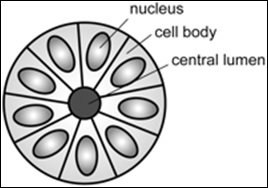Palisade (pathology)





Palisade (pathology)
In pathology, the term palisade refers to a specific histological pattern characterized by the arrangement of cells in a linear, fence-like formation. This pattern is often observed in certain types of tumors and other pathological conditions.
Histological Features[edit]
Palisading is typically seen in the context of basal cell carcinoma, a common type of skin cancer. In this condition, the tumor cells are arranged in parallel rows, resembling a palisade. This arrangement is thought to be due to the way the cells grow and interact with the surrounding stroma.
Clinical Significance[edit]
The presence of palisading can be an important diagnostic feature. For example, in basal cell carcinoma, the identification of palisading can help differentiate it from other types of skin cancer such as squamous cell carcinoma or melanoma. Palisading is also seen in other conditions such as schwannomas and certain types of gliomas.
Associated Conditions[edit]
Diagnosis[edit]
The diagnosis of conditions exhibiting palisading typically involves a combination of clinical examination, imaging studies, and histopathological analysis. A biopsy followed by microscopic examination is often required to confirm the presence of palisading and to determine the exact nature of the pathological condition.
Treatment[edit]
The treatment of conditions exhibiting palisading depends on the underlying cause. For example, basal cell carcinoma is often treated with surgical excision, radiation therapy, or topical medications. The specific treatment plan is determined based on the type, location, and extent of the disease.
Prognosis[edit]
The prognosis for conditions exhibiting palisading varies widely depending on the underlying pathology. For instance, basal cell carcinoma generally has an excellent prognosis with appropriate treatment, while the prognosis for gliomas can be more variable and depends on factors such as the tumor grade and location.
See Also[edit]
Ad. Transform your life with W8MD's Budget GLP-1 injections from $49.99


W8MD offers a medical weight loss program to lose weight in Philadelphia. Our physician-supervised medical weight loss provides:
- Weight loss injections in NYC (generic and brand names):
- Zepbound / Mounjaro, Wegovy / Ozempic, Saxenda
- Most insurances accepted or discounted self-pay rates. We will obtain insurance prior authorizations if needed.
- Generic GLP1 weight loss injections from $49.99 for the starting dose of Semaglutide and $65.00 for Tirzepatide.
- Also offer prescription weight loss medications including Phentermine, Qsymia, Diethylpropion, Contrave etc.
NYC weight loss doctor appointmentsNYC weight loss doctor appointments
Start your NYC weight loss journey today at our NYC medical weight loss and Philadelphia medical weight loss clinics.
- Call 718-946-5500 to lose weight in NYC or for medical weight loss in Philadelphia 215-676-2334.
- Tags:NYC medical weight loss, Philadelphia lose weight Zepbound NYC, Budget GLP1 weight loss injections, Wegovy Philadelphia, Wegovy NYC, Philadelphia medical weight loss, Brookly weight loss and Wegovy NYC
|
WikiMD's Wellness Encyclopedia |
| Let Food Be Thy Medicine Medicine Thy Food - Hippocrates |
Medical Disclaimer: WikiMD is not a substitute for professional medical advice. The information on WikiMD is provided as an information resource only, may be incorrect, outdated or misleading, and is not to be used or relied on for any diagnostic or treatment purposes. Please consult your health care provider before making any healthcare decisions or for guidance about a specific medical condition. WikiMD expressly disclaims responsibility, and shall have no liability, for any damages, loss, injury, or liability whatsoever suffered as a result of your reliance on the information contained in this site. By visiting this site you agree to the foregoing terms and conditions, which may from time to time be changed or supplemented by WikiMD. If you do not agree to the foregoing terms and conditions, you should not enter or use this site. See full disclaimer.
Credits:Most images are courtesy of Wikimedia commons, and templates, categories Wikipedia, licensed under CC BY SA or similar.
Translate this page: - East Asian
中文,
日本,
한국어,
South Asian
हिन्दी,
தமிழ்,
తెలుగు,
Urdu,
ಕನ್ನಡ,
Southeast Asian
Indonesian,
Vietnamese,
Thai,
မြန်မာဘာသာ,
বাংলা
European
español,
Deutsch,
français,
Greek,
português do Brasil,
polski,
română,
русский,
Nederlands,
norsk,
svenska,
suomi,
Italian
Middle Eastern & African
عربى,
Turkish,
Persian,
Hebrew,
Afrikaans,
isiZulu,
Kiswahili,
Other
Bulgarian,
Hungarian,
Czech,
Swedish,
മലയാളം,
मराठी,
ਪੰਜਾਬੀ,
ગુજરાતી,
Portuguese,
Ukrainian
